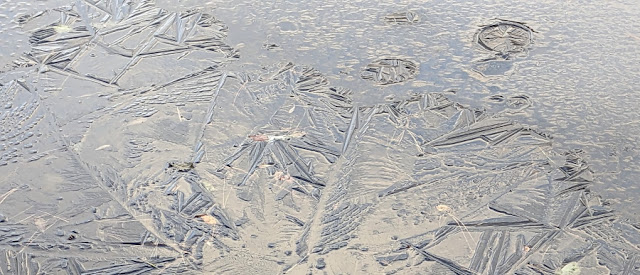I had the good fortune this week to be walking the trails behind Lake Wicwas with a group of friends when we came upon some needle ice beside the trail. The ground was warm and well saturated from recent rain and snow, and the night before was cold enough to freeze water exposed to the surface, providing the right ingredients for these cool crystals to grow.
 |
| Needle ice growing up out of warm, wet soil. |
Once an ice crystal is formed on the bottom of a grain of sand, heat from below is transferred through the stone to the air which cools the water beneath it, resulting in more water freezing at the bottom of the crystal. As the process continues the crystal grows skyward creating needle ice.
 |
| Sand and small stones provide the heat path to start the process. A few beechnut shells rode up on top. |
Late fall is the time when conditions are right for these to form, and it's always a treat to find them.
On cold, calm nights this week, interesting ice patterns were forming in other places too, such as on the surface of the lake in secluded areas.
These always remind me of Disney's Fantasia, and the fairies transforming water into ice to the music of Tchaikovsky's Waltz of the Flowers from his Nutcracker Suite. I didn't realize those swirling ice creations were real until I saw these flourishes for the first time with my own eyes.
Wednesday morning we got our first measurable snow, which thankfully was cleared out in time for the big Thanksgiving travel day. And as if on queue, that morning the snow birds appeared - a big flock of them.
 |
| Dark-eyed juncos, aka snowbirds. |
They were happily picking seeds that were exposed where I had cleared snow from the road. There are lots of hemlocks and a few while pines over the road here, so those are most likely what they were feasting on.
We've all noticed how big the white pine seed crop was this year, as have the squirrels. I came across this huge stash of white pine cones which a red squirrel must have collected this fall.
 |
| A large cache of pine cones collected beneath a large Eastern white pine. |
Then, just a few feet away, were three more piles.
 |
| The pantry is strategically located around the dining table where Mr. Squirrel can safely observe his surroundings while he dines. |
This is quite a winter pantry - one squirrel won't go hungry this winter. I'll try to remember to visit this spot a few times during the winter.
I hope the juncos and squirrels weren't the only creatures that feasted well this week. I hope you too had a wonderful Thanksgiving with food, family, and friends - quiet, peaceful, and safe.
 |
| Happy Thanksgiving from Lake Wicwas. |




































